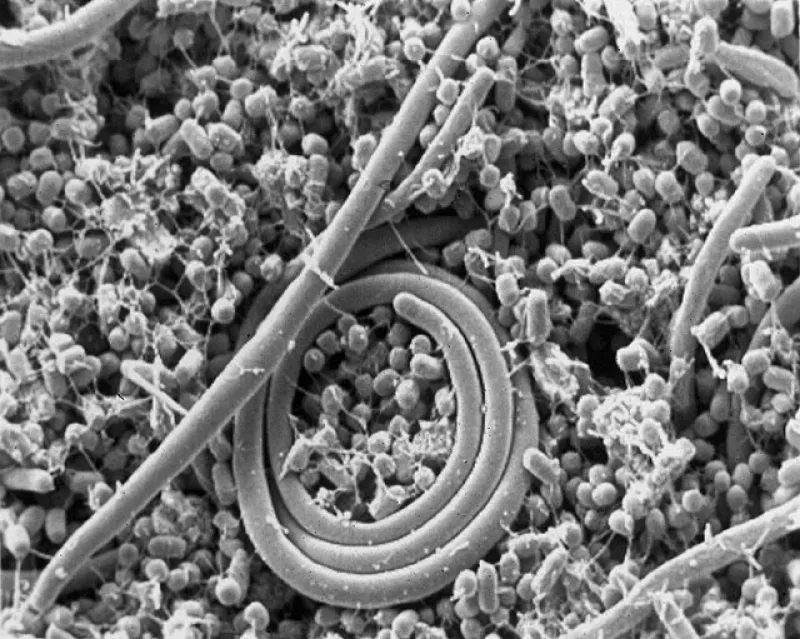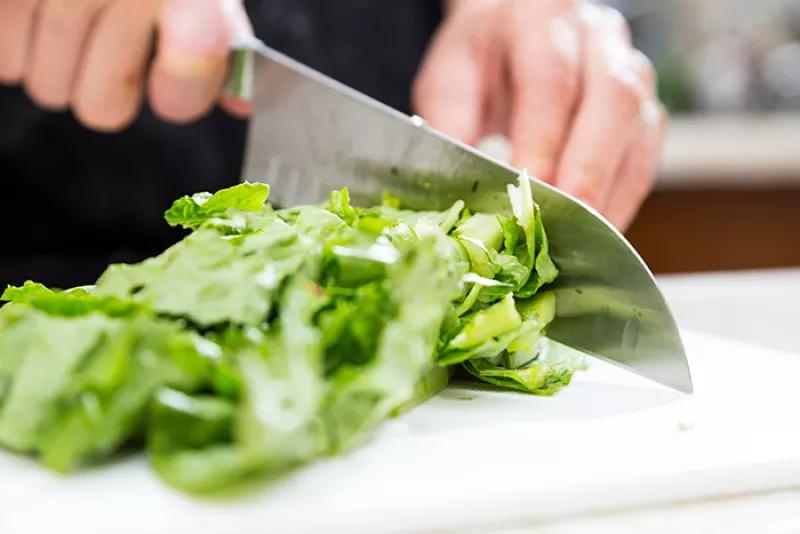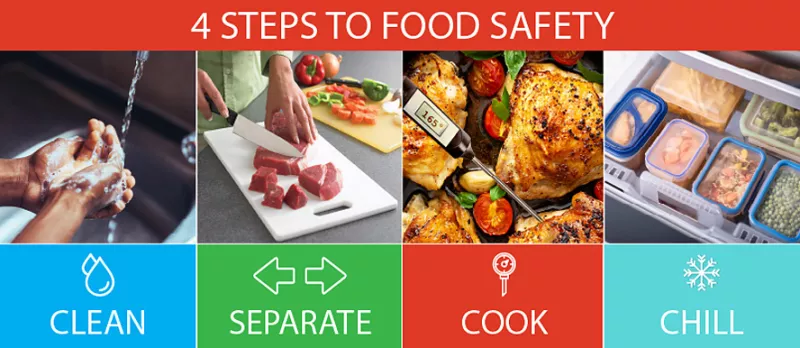Food poisoning is all too common. Here’s how to avoid it at home

zakiroff - stock.adobe.com.
About 48 million Americans contract foodborne illnesses each year. Here’s what you should know about Salmonella and other contamination in everything from romaine lettuce to frozen chicken, and how to avoid it in your home kitchen.
’The safest food supply in the world’
The new Netflix documentary, “Poisoned: The Dirty Truth About Your Food,” shines a light on the gaps in America’s food safety regulations and reveals the unexpected sources of foodborne illnesses like E. coli and Salmonella in food. This may shock some viewers, as government bodies and officials have touted our food supply as “the safest in the world” for many years.
Sarah Sorscher, CSPI’s Director of Regulatory Affairs, writes:
The truth is, our food is nowhere near as safe as it should be. Regulators and the food industry have not done enough to mitigate deadly pathogens, and consumers remain ill-prepared to manage food poisoning risks in our kitchens. We continue to be sickened and die at unacceptably high rates due to contaminated foods as a result.
No food is safe from harboring dangerous pathogens. Peanut butter caused nine deaths in 2008 and 2009 after a massive Salmonella outbreak originated in the Peanut Corporation of America facilities. Bill Marler, featured in “Poisoned” and widely hailed as America’s leading food safety litigator, says a significant number of his clients were sickened by romaine lettuce. Earlier this year, Gold Medal recalled some flour products because they were tainted with Salmonella. And though they account for only 0.15% of the poultry market, frozen, stuffed, breaded chicken products cause 5% of Salmonella outbreaks from chicken.

Until the agencies overseeing the United States’ food supply work to cover the gaps in their authority that let this rampant contamination persist, the onus is on consumers—that is, everyone who eats food—to protect themselves. But it’s not all bad news. In addition to revealing the germy underbelly of the nation’s food system, “Poisoned” offers a ray of hope, Sorscher notes:
The documentary also highlights the moments when outrage has translated into effective change, such as when USDA moved to ban pathogenic E. coli from ground beef in the 1990s, resulting in dramatic declines in illnesses from beef.
While CSPI continues to press for better regulatory oversight and healthier industry practices, consumers are left to protect their own health at home. It seems like a daunting task, but the NutritionAction team have identified some best practices for consumers. Here are our top tips for keeping your kitchen clear of foodborne pathogens.
In-store food safety

While we can’t control what happens to our food before we buy it, there are several ways we can minimize foodborne illness that begin at the grocery store.
- When shopping, keep fruit, leafy greens, and other vegetables in your cart in a separate bag to avoid touching products likely to harbor bacteria, like meat and eggs.
- Choose items that are free from bruises, broken skins or peels, and other damage, as these are easy targets for hungry bacteria.
- Use produce bags like a glove to pick up and wrap raw meat, poultry, and seafood packages to avoid getting bacteria on your hands and touching other foods.
- Unless you cook your meat until it’s well done, skip “mechanically tenderized,” “needle tenderized,” or “blade tenderized” beef. It’s been pierced by tiny needles that can push microbes from the surface into the meat.
- Frozen fish should be rigid, not bendable, and free of ice crystals, as these are signs that the fish was held at a temperature warm enough to grow toxin-producing bacteria.
- Make sure the deli clerk puts on new gloves after handling each hunk of meat or cheese and places sliced meat or cheese on paper when weighing it.
- Don’t buy more deli meat than you can eat within a few days. Listeria can grow at refrigerator temperatures.
- If you purchase precut vegetables or fruit, you choose items that are refrigerated or kept on ice, as bacteria grow easily on pre-cut produce.
- When checking out, use separate bags for fresh produce and animal products. (To minimize waste and plastic use, we recommend bringing your own reusable, washable bags to the store or market, as well, keeping separate bags for produce and animal products.)
- In the summer, the trunk is much hotter than the rest of the car. Try to keep food in the air-conditioned cabin for the drive home, and travel with an insulated cooler if you’ve got a long drive home from the store.
Want more food safety tips for shopping? Check out how to keep your food safe at the supermarket at NutritionAction.
Food safety in the kitchen

Starting with clean hands can help reduce transfer of bacteria from other sources to your food, and washing hands after handling produce or other food products reduces the chances of spreading foodborne bacteria elsewhere.
For the same reasons, clean your countertops, cutting boards, storage containers and other hard surfaces before and after cutting or prepping your produce.
How should you clean? Use a two-step process that includes cleaning first and then disinfecting (which kills bacteria and viruses):
- To remove dirt and grease, clean all surfaces with warm water and dishwashing liquid (or a store-bought cleaner).
- Then disinfect with diluted bleach (1 teaspoon per cup of water) made in the past 24 hours.
- Or use a store-bought EPA-registered disinfectant (the label will say “EPA REG. NO.”). Most disinfectants need a few minutes to do their job, so don’t wipe immediately.
And, on the matter of cutting boards, Ben Chapman, an associate professor and food safety extension specialist at North Carolina State University, suggests plastic for meat, fish, and poultry, and wood for fruit, vegetables, bread, and cheese. But either can work. “As long as you wash your boards with soap and water and dry them, it doesn’t matter which you use,” he says.
Time to get another cutting board? Bacteria can hide out in hard to clean grooves even with regular cleaning. Replacing worn-out boards and using one cutting board for fresh produce and bread and a separate one for raw meat, poultry, and seafood makes it easier to prevent bacteria that are common on raw meat, poultry, or seafood from contaminating a food that requires no further cooking.
Safe storage
Some foods should be stored at room temperature, and others should be refrigerated immediately. Knowing where to store which foods is not always intuitive, though; do tomatoes go on the countertop or in the crisper bin? (The answer is “both,” as tomatoes are fine at room temp until they’re cut, and must be refrigerated afterward.)
- Your storage areas, be they pantry, bins, baskets, or the fridge, should be clean and dry.
- Peeled or cut produce, meat, dairy, and eggs should be stored in closed containers in the refrigerator.
- Your refrigerator should be 40º F or cooler. Use a thermometer!
Food safety tips for produce

All fruit and veg harbor some kind of bacteria (though most bacteria won’t make you sick), usually transferred from irrigation water or soil before transport to grocery stores—and then from handling, shelving, and other shoppers before it reaches your cart. This is true even for organic produce—which just means a crop has been grown with fewer and less-synthetic pesticides and fertilizers.
- No washing method can remove all harmful germs (like E. coli O157:H7), but rinsing your lettuce, tomatoes, potatoes, and other whole foods can help prevent the transfer of “bad germs” to your plate. (Skip produce washes, which work no better than running water and may leave chemical residues on your fruits and veggies.)
- Potatoes, onions, and unripened fruits like apples and melons do well in room temperature storage, but leafy greens, root vegetables like carrots and radishes, and fruit should be refrigerated. (For detailed guidance, here’s a handy produce storage chart from the University of Maine.)
When to rinse
There is some debate about whether it’s better to clean produce before storage or before use. We’re on Team Before Storage, provided you take care to thoroughly dry your veg and fruit; storing damp produce encourages mold growth, and that’s not great for you, either.
Before cutting, rinse fruits and vegetables under running water, even if you don’t plan to eat the peel or rind (like melons). Why? A knife can transfer pathogens from rind to flesh. Use a produce brush to scrub melon, avocado, and other firm fruits or vegetables.
Food safety tips for seafood and meat

The first two tips for safely consuming meat or seafood are to keep it chilled (that is, stored at 40º F or below) until it’s ready to cook, and to cook it to its recommended temperature. For reference, chicken should reach 165º F, while beef, pork, lamb (ground) should be cooked to 160º F, and beef, pork, lamb (steaks or chops) to 145º F. Cook fish to 145º F or until the flesh is opaque and separates easily with a fork.
That means there are two tools everyone should have on hand: “A good meat thermometer and a good refrigerator thermometer,” says Donald Schaffner, an extension specialist in food science and a professor in the School of Environmental and Biological Sciences at Rutgers University.
- “Get a tip-sensitive digital thermometer that can tell you the temperature of cooked meat almost instantly. It’s a small price to pay to keep you and your family safe, because you can’t always tell by looking whether meat or poultry has been cooked to a safe temperature.”
- Your refrigerator’s temperature should be no greater than around 40º F to keep food fresh and prevent most pathogens from growing. “Someday all refrigerators will have a thermometer built in,” says Schaffner. Until that day comes, we should all buy our own.
Avoiding cross-contamination
Cross-contamination means pathogens move from one food to another, or from a raw food to the same food after cooking.
- To minimize the risk, clean utensils, knives and cutting boards before and after using them, and never use the same tools for a raw product and a ready-to-eat food (like cooked foods or foods that won’t be cooked like a salad).
- Wash your hands frequently in the kitchen, for at least 20 seconds with warm water and soap before and after preparing any food.
- In the refrigerator, keep raw meat, poultry, and seafood wrapped securely or in a sealed container. Better yet, keep them in their own drawer or on a bottom shelf in case they leak.
- Store all cooked foods and cut or peeled produce in containers, storage bags, or wrapped in foil or beeswax wraps.
- Washing raw meat does not eliminate harmful bacteria and could splash them onto surfaces that contact produce and other foods eaten raw.
Food safety tips for eggs and dairy products

Foods containing uncooked eggs—most often made at home—are often linked to food poisoning. Don’t eat raw cookie dough—the eggs and flour could both cause illness—and for homemade foods that require raw eggs (like mayo or ice cream), use pasteurized eggs, store at the appropriate temperature (that's 40º F), and use it quickly to reduce the risk of illness.
- Check eggs at the store for cracks and cleanliness before buying.
- Like a runny yolk? Look for pasteurized eggs, which have been treated to kill Salmonella.
- Store eggs in the fridge in their cartons.
- Dairy of all kinds should be stored in the refrigerator, with the exception of shelf-stable milk.
- Unpasteurized milk and dairy products are more likely to be contaminated with the kinds of pathogens that make people very sick, and should be avoided.
- Never leave eggs, milk, or other dairy products at room temperature for more than two hours.
Food safety tips for frozen foods

Is that chicken precooked? You might be surprised; though most frozen breaded foods look like they’re cooked, if they’re labeled “raw” they are, and should be handled accordingly:
- Cook frozen foods to the recommended temperature stated on the package.
- Never use the same utensils, cutting boards, or plates for cooked foods that you used for raw foods.
- Use a meat thermometer to ensure the internal temp matches the cooking directions on the packaging.
- Avoid any frozen food, especially frozen seafood or meat, that has ice crystals on it. That may mean that it has been stored for a long time or thawed and refrozen.
- Don’t thaw meat, poultry, or fish at room temperature. Bacteria can grow on the edges even as the center remains frozen. To speed thawing, immerse in cold water. Learn more safe thawing methods from USDA.
- Always open the package when thawing vacuum-sealed fish. Botulism-causing bacteria can grow on fish at refrigerator temperature, but dies when exposed to air.
More food safety guidelines
Not all food happens at home! Picnics, camping trips, cookouts, and farmers' markets all have special considerations. Learn how to steer clear of food poisoning this summer, what the date labels on foods actually mean, and 7 helpful tips for keeping your food safe at NutritionAction.
Not everyone is equally susceptible to foodborne illness. The CDC says adults aged 65 and older, children younger than age 5, people who have health problems or take medicines that weaken the immune system—for example, people with diabetes, liver or kidney disease, HIV, or cancer—and people who are pregnant should take special care to observe food safety guidelines.

This is a lot of guidance! To keep it simple, remember to always Clean, Separate, Cook, and Chill your food. This means clean your food and your hands and surfaces; keep produce and animal products separate from each other, and don’t cross contaminate between raw and cooked foods; cook meat, seafood, and eggs to their proper temperatures; and promptly refrigerate cooked foods, cut produce, and any food that should be stored below room temperature.
Support CSPI today
As a nonprofit organization that takes no donations from industry or government, CSPI relies on the support of donors to continue our work in securing a safe, nutritious, and transparent food system. Every donation—no matter how small—helps CSPI continue improving food access, removing harmful additives, strengthening food safety, conducting and reviewing research, and reforming food labeling.
Please support CSPI today, and consider contributing monthly. Thank you.

Subscribe to Nutrition Action
We name names, remain strictly objective, and deliver scrupulously researched advice about food of all kinds, staying healthy with diet and exercise, and more.

